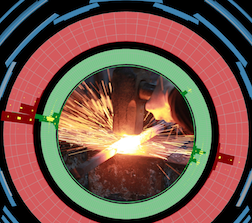Lepton Flavour Universality is enforced in the Standard Model by construction. Any Violation
of LFU would be a clear sign of new physics. Existing hints of non universality are
already present in the leptonic and semileptonic decays of B mesons. The semitauonic decays in particular,
are sensitive to contributions from non-standard-model-particles that preferentially couple to
the third...
Probes of CP-violation in decays of Beauty-strange meson and a high sensitivity measurements of the rare Bs decays with the ATLAS detector, using Run1 data are presented. Highlights on the expected performance for Run2 will be shown.
ATLAS has a wide program to study the production properties of
conventional and exotic quarkonium, beauty, and charm bound states.
This presentation will cover the latest results on J/$\psi$, $\psi$(2s) and
$\Upsilon$ production at 7, 8, and 13 TeV, D meson and $\chi$(3872) production
with Run-1 data, B+ production at 13 TeV, and studies of associated
production of quarkonium with other...
The discovery of the first pentaquark states and the first unambiguous
determination of the Zc(4430) as a tetraquark state achieved at LHCb in
the last years have incredibly increased the interest for exotic
hadrons containing heavy quarks. An overview of the
recent LHCb results on quarkonium-like hadrons is presented, including a study of the Bs 𝜋± system
We use e^+ e^- to 2 Jets and 3 Jets processes to study the fragmentation of B mesons and J/psi in identified jets with specific shapes (Angularities).
I will introduce the eletromagnetic decays of the $B_c(2S)$ meson, which is recently observed by the ATLAS. In the calculation, the instantaneous Bethe-Salpeter method is used, and our results show that the branching ratio of eletromagnetic decays of this particle is about $10\%$ of the whole decay width.
We will talk about the production of D-wave charmonia ($2^{-+}$, $2^{--}$, $3^{--}$) in the weak decays of $B_c$ meson. The wave functions of the heavy mesons are achieved by solving the instantaneous Bethe-Salpeter equation. The three-gluon decay processes of these charmonia are also investigated.
